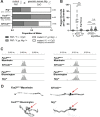This is a preprint.
Fas2EB112: A Tale of Two Chromosomes
- PMID: 38260405
- PMCID: PMC10802346
- DOI: 10.1101/2024.01.03.574100
Fas2EB112: A Tale of Two Chromosomes
Update in
-
Fas2EB112: a tale of two chromosomes.G3 (Bethesda). 2024 May 7;14(5):jkae047. doi: 10.1093/g3journal/jkae047. G3 (Bethesda). 2024. PMID: 38447284 Free PMC article.
Abstract
The cell-cell adhesion molecule Fasciclin II (Fas2) has long been studied for its evolutionarily-conserved role in axon guidance. It is also expressed in the follicular epithelium, where together with a similar protein, Neuroglian (Nrg), it helps to drive the reintegration of cells born out of the tissue plane. Remarkably, one Fas2 protein null allele, Fas2G0336, demonstrates a mild reintegration phenotype, whereas work with the classic null allele Fas2EB112 showed more severe epithelial disorganization. These observations raise the question of which allele (if either) causes a bona fide loss of Fas2 protein function. The problem is not only relevant to reintegration but fundamentally important to understanding what this protein does and how it works: Fas2EB112 has been used in at least 37 research articles, and Fas2G0336 in at least three. An obvious solution is that one of the two chromosomes carries a modifier that either suppresses (Fas2G0336) or enhances (Fas2EB112) phenotypic severity. We find not only the latter to be the case, but identify the enhancing mutation as Nrg14, also a classic null allele.
Conflict of interest statement
Competing Interests: The authors declare no competing interests.
Figures




References
-
- Araújo Sofia J, and Guy Tear. 2003. “Axon Guidance Mechanisms and Molecules: Lessons from Invertebrates.” Nature Reviews. Neuroscience 4 (11): 910–22. - PubMed
-
- Bergstralh Dan T, Dawney Nicole S, and Johnston Daniel St. 2017. “Spindle Orientation: A Question of Complex Positioning.” Development 144 (7): 1137–45. - PubMed
-
- Bieber Allan J, Snow Peter M, Hortsch Michael, Patel Nipam H, Roger Jacobs J, Traquina Zaida R, Schilling Jim, and Goodman Corey S. 1989. “Drosophila Neuroglian: A Member of the Immunoglobulin Superfamily with Extensive Homology to the Vertebrate Neural Adhesion Molecule L1.” Cell 59 (3): 447–60. - PubMed
-
- Brand A H, and Perrimon N. 1993. “Targeted Gene Expression as a Means of Altering Cell Fates and Generating Dominant Phenotypes.” Development 118 (2): 401–15. - PubMed
Publication types
Grants and funding
LinkOut - more resources
Full Text Sources
